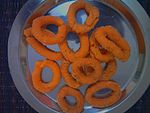 | |
| Type | Snack |
|---|---|
| Place of origin | India |
| Region or state | Andhra Pradesh, Telangana |
| Main ingredients | Rice flour |
Chakodi, also known as chagodi, is a hot and crunchy Indian snack. It is made with rice flour and is round in shape. [1]
 | |
| Type | Snack |
|---|---|
| Place of origin | India |
| Region or state | Andhra Pradesh, Telangana |
| Main ingredients | Rice flour |
Chakodi, also known as chagodi, is a hot and crunchy Indian snack. It is made with rice flour and is round in shape. [1]
Chakodi are made from rice flour and chilli powder.

A dosa is a thin savory pancake in South Indian cuisine made from a fermented batter of ground black lentils and rice. Dosas are served hot, often with chutney and sambar. Dosa is a signature dish in South India and Sri Lanka, and is popularly served in their respective restaurants around the world.

Bhelpuri is a savoury snack originally from India, and is also a type of chaat. It is made of puffed rice, vegetables and a tangy tamarind sauce, and has a crunchy texture.

Pakora is a fritter originating from the Indian subcontinent. They are sold by street vendors and served in restaurants in South Asia. It consists of items, often vegetables such as potatoes and onions, coated in seasoned gram flour batter and deep fried.

A fritter is a portion of meat, seafood, fruit, vegetables, or other ingredients which have been battered or breaded, or just a portion of dough without further ingredients, that is deep-fried. Fritters are prepared in both sweet and savory varieties.
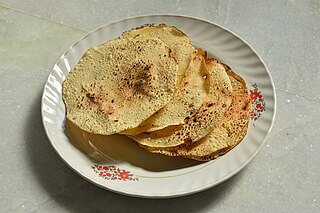
A papadam, also known as a papad, is an Indian dough of black gram bean flour, either deep fried or cooked with dry heat until crunchy. Other flours made from lentils, chickpeas, rice, tapioca, millet or potato are also used. Papad is typically served as an accompaniment to a meal in India, Pakistan, Bangladesh, Nepal, Sri Lanka and the Caribbean or as an appetizer, often with a dip such as chutneys or toppings, such as chopped onions and chili peppers, or they may be used as an ingredient in curries.

Puri is a deep-fried bread made from unleavened whole-wheat flour that originated in the Indian subcontinent. It is eaten for breakfast or as a snack or light meal. It is usually served with a savory curry or bhaji, as in puri bhaji, but may also be eaten with sweet dishes.

Chakli is a savoury snack from India. It is a spiral shaped snack with a spiked surface.

Idiyappam, also known as string hopper, indiappa, noolputtu, noolappam, or ottu shavige, is a string hopper dish originating from the Indian state of Kerala and Tamilnadu. It consists of rice flour pressed into noodles, laid into a flat disc-like shape and steamed. The dish also spread to Southeast Asia, where it is called putu mayam in Malaysia and Singapore, and putu mayang in Indonesia.
Maharashtrian or Marathicuisine is the cuisine of the Marathi people from the Indian state of Maharashtra. It has distinctive attributes, while sharing much with other Indian cuisines. Traditionally, Maharashtrians have considered their food to be more austere than others.
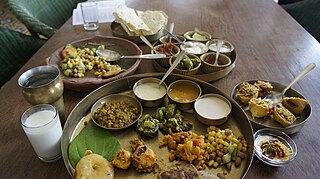
Gujarati cuisine is the cuisine of the Indian state of Gujarat. The typical Gujarati thali consists of rotli, dal or curry, rice, and shaak. The thali will also include preparations made from pulses or whole beans such as moong, black eyed beans etc., a snack item (farsaan) like dhokla, pathra, samosa, fafda, etc. and a sweet (mishthaan) like mohanthal, jalebi, doodh pak etc.

Appam (Malayalam:അപ്പം) or āppa is a type of thin pancake originating from South India and Sri Lanka. It is made with fermented rice batter and coconut milk, traditionally cooked in an appachatti, a deep pan similar in shape to a wok. It is part of Kerala and Tamil cuisine found in the Indian states of Kerala, Tamil Nadu and Sri Lanka. Appam are most frequently served for breakfast or dinner, often with a topping such as an egg.

A rice cake may be any kind of food item made from rice that has been shaped, condensed, or otherwise combined into a single object. A wide variety of rice cakes exist in many different cultures in which rice is eaten and are particularly prevalent in Korea and Japan. Common variations include cakes made with rice flour, those made from ground rice, and those made from whole grains of rice compressed together or combined with some other binding substance.

Kue is an Indonesian bite-sized snack or dessert food. Kue is a fairly broad term in Indonesian to describe a wide variety of snacks including cakes, cookies, fritters, pies, scones, and patisserie. Kue are made from a variety of ingredients in various forms; some are steamed, fried or baked. Kue are popular snacks in Indonesia, which has the largest variety of kue. Because of the countries' historical colonial ties, Koeé (kue) is also popular in the Netherlands.

Ada, Ela Ada, Patholi, Genasele, or Yelaiyappam is an Indian sweet and traditional Kerala, Karnataka and Konkan delicacy,it can be seen even in parts of Tamil Nadu as well, onsisting of rice parcels encased in a dough made of rice flour, with sweet fillings, steamed in banana leaf and served as an evening snack or as part of breakfast. Grated coconut and rice flour are the two main ingredients. It is a snack made out of raw rice flour, sugar or jaggery and grated coconut. It is usually prepared on Onam. Poovada is prepared in the tip end of the plantain leaf as the Nivedyam for Onam, into this ada goes, with the coconut filling, a sprinkling of the Thumbapoo, making it more auspicious. Sometimes banana is also added in the filing which is coconut-jaggery-banana filling. Spicy Ottada is a unique breakfast with maida and rice flour as the main ingredients. It can be also made without maida, but using the rice flour alone and it is not steamed instead cooked on Tava or flame. Sometimes the fillings inside ada would be Chakkavaratti. Ada is also given as Prasadam to devotees at temples in Kerala.

Malaysian Indian cuisine, or the cooking of the ethnic Indian communities in Malaysia, consists of adaptations of authentic dishes from India, as well as original creations inspired by the diverse food culture of Malaysia. Because the vast majority of Malaysia's Indian community are of South Indian descent, and are mostly ethnic Tamils who are descendants of immigrants from a historical region which consists of the modern Indian state of Tamil Nadu and Sri Lanka's Northern Province, much of Malaysian Indian cuisine is predominantly South Indian inspired in character and taste. A typical Malaysian Indian dish is likely to be redolent with curry leaves, whole and powdered spice, and contains fresh coconut in various forms. Ghee is still widely used for cooking, although vegetable oils and refined palm oils are now commonplace in home kitchens. Before a meal it is customary to wash hands as cutlery is often not used while eating, with the exception of a serving spoon for each respective dish.
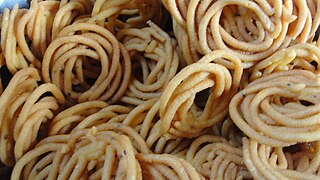
Murukku Tamil – முறுக்கு) is a savoury, crunchy snack originating from the Indian subcontinent. The name murukku derives from the Tamil word for "twisted", which refers to its shape. In India, murukku is especially common in the states of Andhra Pradesh, Odisha, Tamil Nadu, Karnataka, and Kerala. It is called murkulu or janthukulu in Andhra Pradesh. It is also common in countries with substantial Indian and Sri Lankan diaspora communities, including Singapore, Fiji, Malaysia, and Myanmar (Burma). Murukku, called sagalay gway in Burmese, is a common snack and is used as a topping for a regional dish called dawei mont di.

Street food, as in other areas of India, are popular in Chennai, despite the common belief in India that street food is unhealthy. The idly sambhar is a popular dish, which is served as breakfast or dinner. Apart from regular South Indian street food, the city's streets are also filled with several North Indian street food outlets, most of them established by North Indian migrants themselves. Gujarati and Burmese are also available. Street food in Chennai is so popular that a game had developed based on the TV show The Amazing Race where contestants have to follow clues to street-food spots in the city.
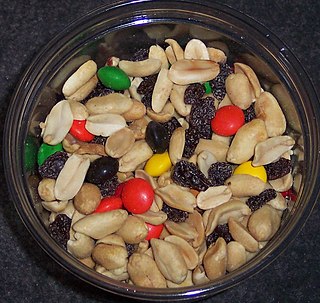
A snack is a small portion of food generally eaten between meals. Snacks come in a variety of forms including packaged snack foods and other processed foods, as well as items made from fresh ingredients at home.

In the Burmese language, the term mont translates to "snack", and refers to a wide variety of prepared foods, ranging from sweet desserts to savory food items that may be cooked by steaming, baking, frying, deep-frying, or boiling. Foods made from wheat or rice flour are generally called mont, but the term may also refer to certain varieties of noodle dishes, such as mohinga. Burmese mont are typically eaten with tea during breakfast or afternoon tea time.